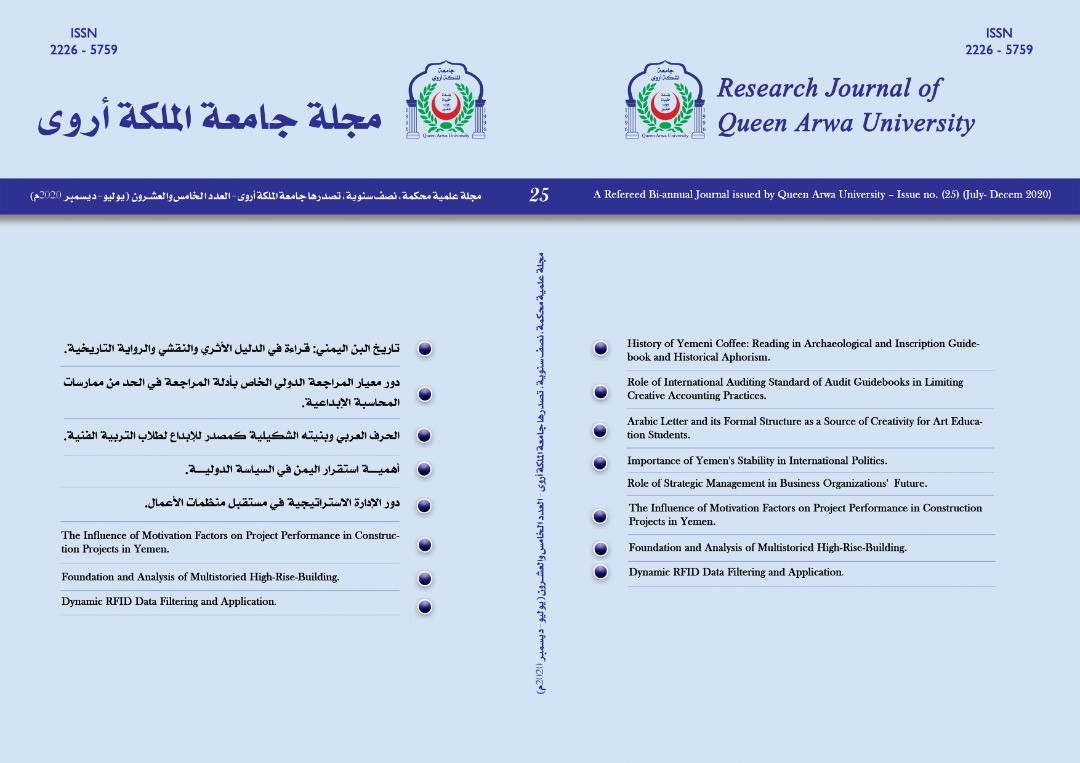تأسيس وتحليل المباني الشاهقة متعددة الطوابق
DOI:
https://doi.org/10.58963/qausrj.v1i25.103الكلمات المفتاحية:
مبنى شاهق ، مبنى RCC ، تحليل ثابت مكافئ ، أساس ، إزاحةالملخص
يعد تحليل وتصميم المباني للقوى الساكنة أمرًا روتينيًا في هذه الأيام بسبب توفر أجهزة كمبيوتر وبرامج متخصصة بأسعار معقولة يمكن استخدامها للتحليل. من ناحية أخرى ، يعد التحليل الديناميكي عملية تستغرق وقتًا طويلاً وتتطلب مدخلات إضافية تتعلق بكتلة الهيكل ، وفهم الديناميكيات الهيكلية لتفسير النتائج التحليلية. تعتبر المباني ذات الهياكل الخرسانية المسلحة (RC) هي أكثر أنواع الإنشاءات شيوعًا في المناطق الحضرية ، والتي تخضع لعدة أنواع من القوى خلال حياتها ، مثل القوى الساكنة بسبب الأحمال الميتة والحيوية والقوى الديناميكية بسبب الرياح والزلازل. هنا الأعمال الحالية (تم أخذ المشكلة) موجودة في مبنى عادي مكون من 35 طابقًا. تبلغ مساحة هذه المباني 25 م × 45 م مع ارتفاع كل طابق 3.6 م وعمق الأساس 2.4 م. والارتفاع الكلي للمبنى المختار شاملاً عمق الأساس 132 م. تصف هذه الورقة التحليل الزلزالي للمباني الشاهقة باستخدام برنامج في STA-ADPro. مع ظروف مختلفة من نظام الصلابة الجانبي. تم إجراء التحليل الثابت والديناميكي على الكمبيوتر بمساعدة برنامج STAAD-Pro باستخدام معلمات التصميم وفقًا للمناطق وتم تلخيص نتيجة المعالجة اللاحقة التي تم الحصول عليها.
المقاييس
التنزيلات
المراجع
Abdalla, J.A. and Al-Homoud, A.S. (2004). "Seismic Hazard Assessment of United Arab Emirates and its Surroundings". J.Earthquake Eng., v. 8, No.6, 617-837.
Alrifai, L. (2007). "Rock Socket Piles at Mall of the Emirates, Dubai". Geot. Eng., 160, GE2, 105-120.
Ambraseys, N. N. (1978). "Middle East - a Reappraisal of the Seismicity". Q. Jnl. Eng. Geol. & Hydrogeology, v. 11, 19-32.
ASCE/Sei7-16 £ Minimum Design Loads and Associated Criteria for Buildings and Other Structures
BIS-1893, Criteria for Earthquake resistant design of structures-Part-1, General Provisions and Buildings, Bureau of Indian Standards, New Delhi -2002.
Baker, W. F., Korista, D.S. and Novak, L.C. (2008). "Engineering the World's Tallest Burj Dubai". CTBUH 8th World Congress, Dubai (available on CTBUH website)
Boggs, D. (1997). "Acceleration Indexes for Human Comfort in Tall Buildings - Peak or RMS?" CTBUH Monograph, Ch. 13: Motion Perception Tolerance and Mitigation.
CTBUH (2008). Information from CTBUH website.
Davids, A.J. (2008). "A Postcard from Dubai. Design and Construction of Some of the Tallest Buildings in the World". CTBUH 8th World Congress, Dubai (available on CTBUH website).
E.L.Wilsons and K.Bathe, "Stability and accuracy analysis of direct integration method" Earthquake engineering and Structural dynamics- vol.-1, 1973.
Evans, P.L. (1978). "The Middle East - an Outline of the Geology and Soil Conditions in Relation to Construction Problems". BRE CP13/78, Building Research Establishment, Watford, UK.
Franke, E., Lutz, B. and El-Mossalamy, Y. (1994). "Measurements and Numerical Modelling of High-Rise Buildings on Frankfurt Clay." ASCE Spec. Pub. No. 40, 2: 1325-1336.
Gazetas, G. (1991). "Foundation Vibrations". Ch. 15 of Foundation Engineering Handbook, 2nd Ed., Ed. H.V. Fang, van Nostrand Reinhold, New York.
I.S-13920."Ductile detailing of reinforced structures subjected to seismic force" code of practice Bureau of Indian Standards, New Delhi -1993. [15] IS-456-1978 and. IS-456-2000 "Indian standard of code and practice for plain and reinforced concrete" Bureau of Indian Standards, New Delhi -2000. [16] Kent, P.E. (1978). "Middle East - the Geological Background". Q. Jnl. Eng. Geol. & Hydrogeology, v. 11, 1-7.
Murty.CVR. and Jain.SK"A Review of IS-1893-1984 Provisions on seismic Design of Buildings". The Indian concrete journal, Nov.1994.
Mandolini, A., Russo, G. and Viggiani, C. (2005). Pile foundations: experimental investigations, analysis and design. Proc. 16th Int. Conf. Soil Mechs. Geot. Eng., Osaka, 1: 177-213.
Mendis, P., Ngo, T., Haritos, N., Hira, A., Samali, B., and Cheung, J.(2007). "Wing Loading on Tall Buildings". EJSE Special Issue: Loading on Structures". EJSE International
Poulos, H.G. (2000). "Pile testing from the designer's viewpoint". STATNAMIC Loading Test '98, Kusakabe, Kuwabara & Matsumoto (eds), Balkema, Rotterdam, 3-21.
Poulos, H.G. (2002). "Prediction of Behaviour of Building Foundations due to Tunnelling Operations". Proc. 3rd Int. Symp. On Geot. Aspects of Tunnelling in Soft Ground, Toulouse, Preprint Volume, 4.55-4.61.
Poulos, H.G. (2008). "Simulation of the performance and remediation of imperfect pile groups". Deep Foundations on Bored and Auge Piles, BAPV, Ed. W.F. van Impe and P.O. van Impe, CRC Press, Boca Raton, 143-154. [23] Poulos, H.G. and Chua, E.W. (1985). "Bearing Capacity of Foundations oin Calcareous Sand". Proc. 11th Int. Conf. Soil Mechs. Found. Eng., San Francisco, 3:1619-1622.
Reddell, R.and Llera, J.C.D.L"Seismic analysis and design" Current practice and Future ternds.Eleventh World Conference on earthquake Engineering Mexico.
Taylor, D.W. (1948). "Fundamentals of Soil Mechanics". John Wiley, New York.
Zhang, L. and Ng, A.M.Y. (2006). "Limiting Tolerable Settlement and Angular Distortion for Building Foundations". Probabilistic Applications in Geotechnical Engineering, GSP 170, ASCE (CDvolume).
التنزيلات
منشور
إصدار
القسم
الفئات
الرخصة
الحقوق الفكرية (c) 2020 للمؤلف/المؤلفين المشار إليهم في هذا المقال.

هذا العمل مرخص بموجب Creative Commons Attribution 4.0 International License.













